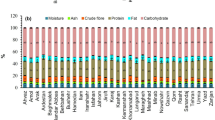Abstract
Data are presented on proximate analyses of the seeds and tuberous roots of Icacina oliviformis(Icacinaceae) from the Central African Republic. The seeds contain 80.7% nitrogen-free extract (NFE), 14.0% crude protein, and 0.5% crude fat (dry weight). The average moisture content of live seeds is 18.3%. The roots contain 84.5% NFE, 4.4% crude protein, and 1.6% crude fat (dry weight). The moisture content of the fresh root is ca. 59%. These results are comparable to those reported for commonly cultivated crops in the study area. The amino acid profile of the seed protein is comparable to that of a protein of moderately high quality, although digestibility was not tested. From a nutritional point of view, this species warrants consideration for integration into agroforestry schemes undertaken in areas where it is currently exploited.
Similar content being viewed by others

Literature Cited
AOAC (Association of Official Analytical Chemists). 1980. Official methods of analysis. 13th ed. Sections 7.015 (crude protein), 7.003 (moisture), 7.057 (crude fat), 7.066-7.068 (crude fiber) and 7.009 (ash). Association of Official Analytical Chemists, Arlington, VA.
Benson, J. V., Jr., and J. A. Patterson. 1971. Chromatographic advances in amino acid and peptide analysis using spherical resins and their applications in biochemistry and medicine. Pages 1–73in A. Niederweiser and G. Patak, ed., New techniques in amino acid, peptide, and protein analysis. Ann Arbor Sci. Publ., Ann Arbor, MI.
Cerighelli, M. R. 1919. La farine des graines et la f’cule des tubercules de l’Icacinasenegalensis. Ann. Inst. Bot.-G’ol. Colon. Marseille 3:169–178.
Fay, J. M. 1987.Icacina oliviformis: A close look at an underexploited food plant. I. Overview and ethnobotany. Econ. Bot. 41:512–522.
Leung, W. 1968. Food composition table for use in Africa. United States Dept. of Health, Education and Welfare and The Food and Agricultural Organization of the United Nations, Bethesda, MD.
Rexroad, P. R., and R. D. Cathey. 1976. Pollution-reduced Kjeldahl method for crude protein. J. Assoc. Off. Analytical Chem. 59:1213–1217.
Schram, E., S. Moore, and E. J. Bigwood. 1954. Chromatographie determination of cystine and cysteic acid. Biochem. J. 57:33–37.
Spies, J. R., and D. C. Chambers. 1949. Chemical determination of tryptophan in proteins. Anal. Chem. 21:1249–1266.
Triebold, H. O. 1946. Quantitative analysis. D. Van Nostrand, New York.
Williams, H. H., A. E. Harper, D. M. Hegsted, G. Arroyave, and L. E. Holt, Jr. 1974. Nitrogen and amino acid requirements. Pages 22–63in National Academy of Sciences. Improvement of protein nutriture. National Academy Press, Washington, DC.
Author information
Authors and Affiliations
Rights and permissions
About this article
Cite this article
Fay, J.M. Icacina oliviformis (icacinaceae): A close look at an underexploited food plant. II. Analyses of food products. Econ Bot 45, 16–26 (1991). https://doi.org/10.1007/BF02860046
Received:
Accepted:
Issue Date:
DOI: https://doi.org/10.1007/BF02860046



